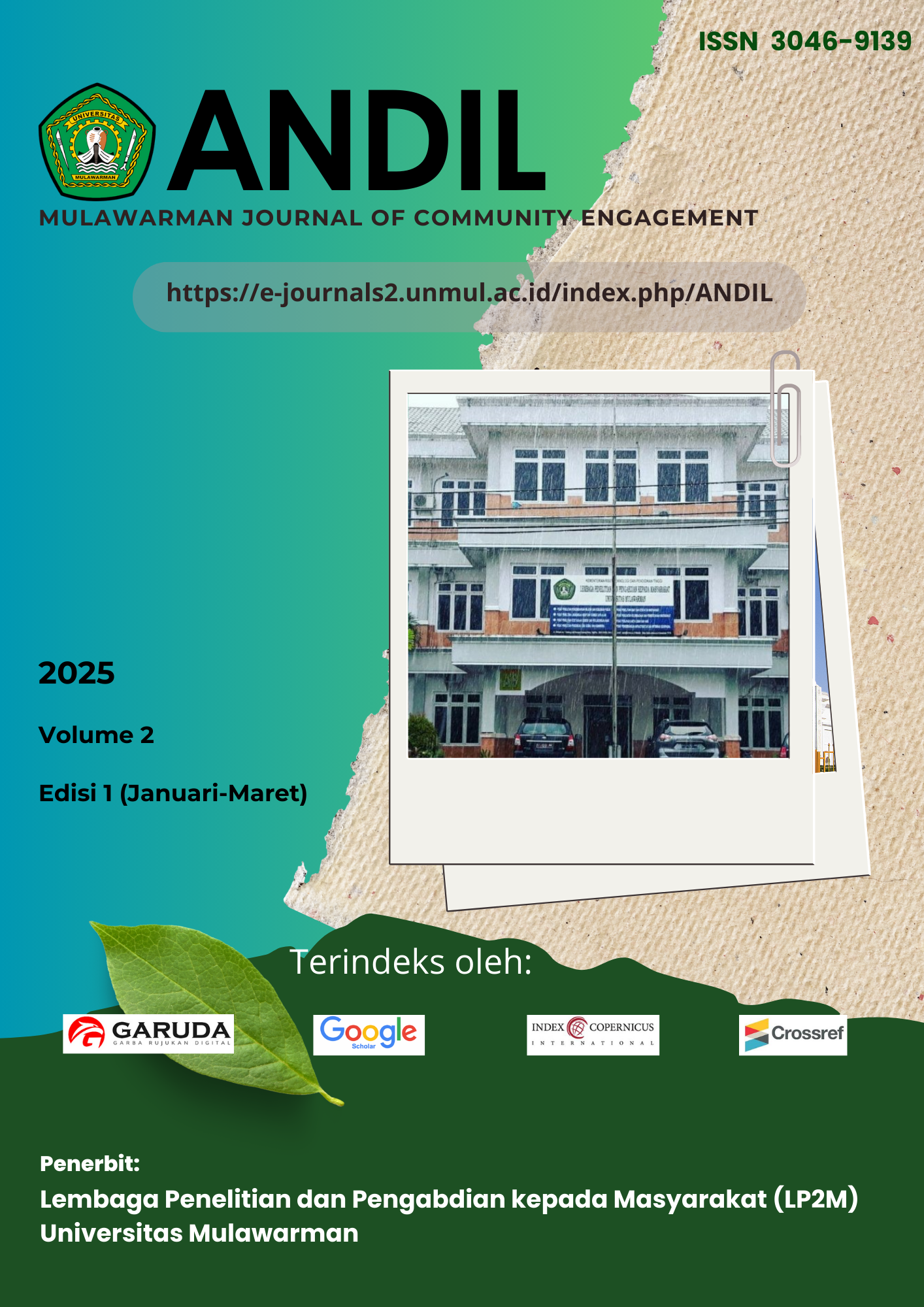Optimalisasi Pengenalan dan Penggunaan Aplikasi Samarinda Santer dalam meningkatkan Pelayanan Publik di Kota Samarinda
DOI:
https://doi.org/10.30872/andil.v2i1.1656Keywords:
Socialization, Samarinda Santer Application, Digital Public Services, Digital LiteracyAbstract
The optimalization of the Samarinda Santer application is part of an effort to enhance digital public services in Samarinda City, specifically in Handil Bakti Village. This jurnal aims to evaluate the effectiveness of the socialization, the challenges encountered, and the social implications of implementing the application. The methods used in the socialization included interactive presentations, application usage simulations, and Q&A sessions, with a focus on community participation. Results indicate an increase in understanding and adoption of the application by the community, although challenges such as varying levels of digital literacy, infrastructure limitations, and resistance to new technology were encountered. The social implications of this socialization include improved accessibility to public services, digital literacy, transparency, and community participation in governance. The paper recommends ongoing technical support, application feature updates, and a more persuasive approach to overcome challenges and enhance technology adoption among the community.
References
Abdullah, A. (2022). Keterbatasan Infrastruktur Digital dan Tantangan Pembangunan di Kalimantan Timur. Jurnal Pembangunan Wilayah, 15(2), 125–138.
Abdullah, A. (2022). Pentingnya Digitalisasi Layanan Publik dalam Mengurangi Kesenjangan Sosial. Jurnal Pembangunan Wilayah, 16(1), 112–128.
Anderson, R. (2011). Infrastructure Challenges in the Digital Public Service Implementation. Journal of Public Administration, 18(3), 102–118.
BPS Samarinda. (2022). Statistik Akses Internet dan Penggunaan Teknologi Informasi di Samarinda. Samarinda. In Badan Pusat Statistik Kota Samarinda.
Gunawan, A. (2019). Infrastruktur Teknologi dan Tantangannya di Indonesia. Jurnal Teknologi Dan Pembangunan, 15(3), 122–138.
Haris, T. (2019). Transparansi dan Akuntabilitas Melalui Teknologi Digital." Jurnal Teknologi dan Pemerintahan. Jurnal Teknologi Dan Pemerintahan, 12(4), 78–93.
Hartono, S. (2020). Keberlanjutan Penggunaan Teknologi di Masyarakat. Jurnal Teknologi Dan Inovasi Sosial, 17(1), 89–104.
Iskandar, M. (2019). Faktor-Faktor Pendukung Adopsi Teknologi di Masyarakat. Jurnal Sosiologi Dan Teknologi, 16(2), 89–105.
Kartini, M. (2019). Literasi Digital di Kalimantan Timur: Tantangan dan Peluang. Jurnal Komunikasi Dan Media, 7(1), 33–47.
Masyhura, N., & Ramadan, Z. H. (2021). Implementation of Digital Literacy in Elementary Schools. International Journal of Elementary Education.
Mesra, B., Ferine, K. F., & Jasmalinda. (2022). Digital literacy to improve the quality of state civil apparatus services for the of Indonesia community. World Journal of Advanced Research and Reviews, 16(3), 1338.
Mulyana, I. (2020). Pentingnya Literasi Digital di Era Teknologi. Jurnal Pendidikan Dan Teknologi, 13(2), 67–82.
Ngiam, N., Yee, W. Q., Teo, N., Yow, K. S., Soundararajan, A., Lim, J. X., Lim, H. A., Tey, A., Tang, K., Tham, C., Tan, J., Lu, S. Y., Yoon, S., Ng, K., & Loe, L. (2022). Building Digital Literacy in Older Adults of Low Socioeconomic Status in Singapore (Project Wire Up): Nonrandomized Controlled Trial. Journal of Medical Internet Research, 24.
Nugroho, A. (2021). Strategi Adopsi Teknologi yang Efektif di Masyarakat Perkotaan. Jurnal Teknologi Dan Inovasi, 14(2), 112–127.
Nugroho, D. (2022). Inovasi Teknologi dalam Pelayanan Publik: Meningkatkan Efisiensi dan Aksesibilitas. Jurnal Administrasi Publik Indonesia, 15(1), 33–49.
Nurhadi, M. (2020). Mengatasi Resistensi Terhadap Teknologi Baru. Jurnal Psikologi Sosial Dan Teknologi, 14(1), 55–70.
Prasetyo, B. (2020). Kesiapan Infrastruktur Teknologi di Wilayah Pedesaan,. Jurnal Teknologi Pedesaan, 10(2), 101–117.
Putra, I., & Ramli, M. (2021). Analisis Literasi Digital Masyarakat Samarinda. Jurnal Teknologi Dan Masyarakat, 14(2), 89–102.
Ramadhan, E. (2020). Teknologi dan Kohesi Sosial di Masyarakat. Jurnal Sosiologi Dan Teknologi, 19(3), 102–118.
Santoso, H. (2020). Efektivitas Pembelajaran Multimodal dalam Konteks Teknologi Digital. Jurnal Teknologi Pendidikan, 15(1), 103–118.
Saputra, J. (2021). Dukungan Sosial dan Adopsi Teknologi Baru. Jurnal Psikologi Dan Teknologi Sosial, 18(3), 112–128.
Sari, N., & Wulandari, T. (2020). Persepsi Masyarakat terhadap Keamanan dan Privasi dalam Penggunaan Aplikasi Digital. Jurnal Keamanan Siber, 5(2), 121–135.
Supriyadi, H. (2021). Efisiensi Birokrasi Melalui Digitalisasi Layanan Publik di Pemerintahan Daerah. Jurnal Administrasi Publik Indonesia, 13(2), 77–92.
Wahyudi, K. (2021). Aksesibilitas Layanan Publik Melalui Teknologi. Jurnal Teknologi Dan Masyarakat, 14(2), 132–147.
Widiastuti, N. (2021). Metode Interaktif dalam Sosialisasi Teknologi. Jurnal Pendidikan Dan Inovasi, 19(1), 78–93.
Wijaya, D. (2019). Kecepatan Adopsi Teknologi di Masyarakat. Jurnal Inovasi Dan Teknologi Sosial, 16(4), 104–119.
Wijaya, P. (2022). Mengatasi Resistensi Terhadap Teknologi Baru dalam Komunitas. Jurnal Komunikasi Dan Teknologi, 19(1), 67–81.
Downloads
Published
How to Cite
Issue
Section
License
Copyright (c) 2025 ANDIL Mulawarman Journal of Community Engagement

This work is licensed under a Creative Commons Attribution 4.0 International License.













